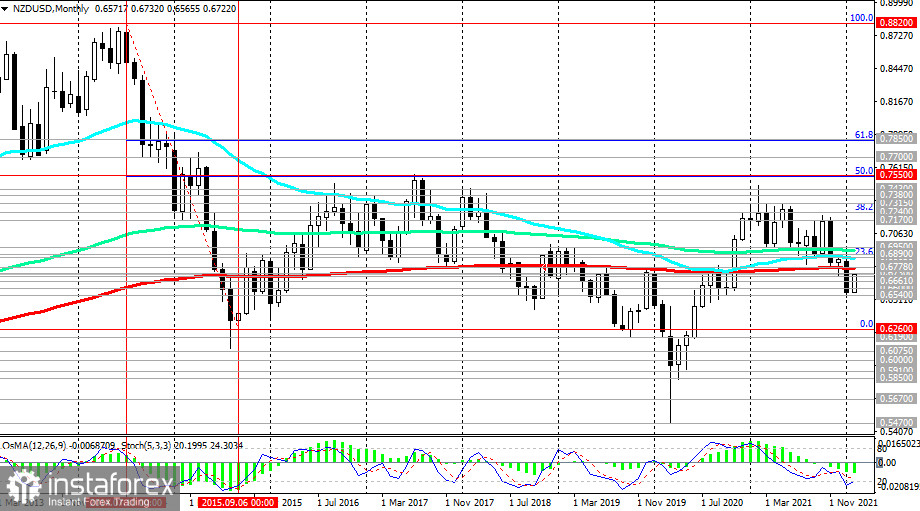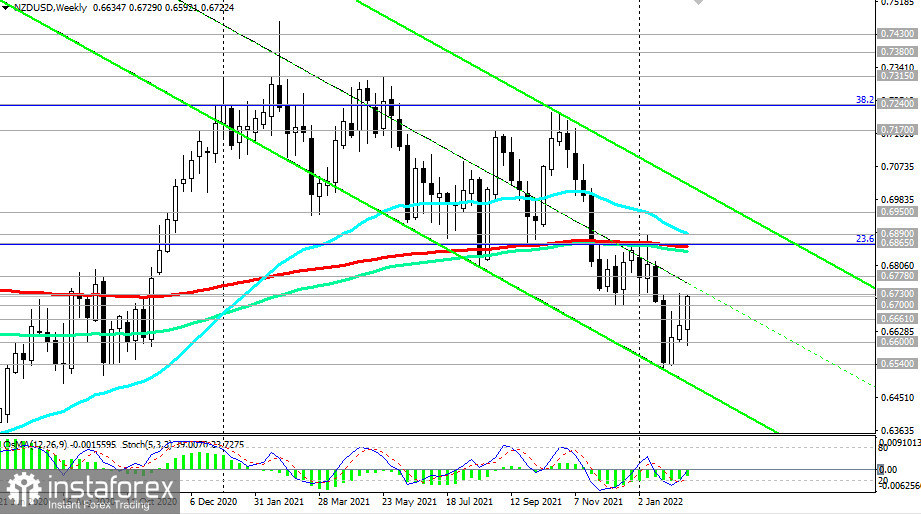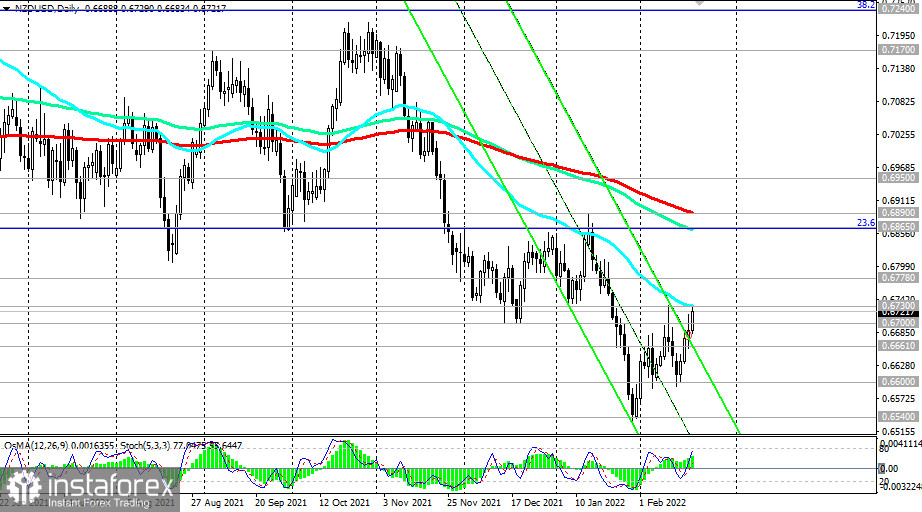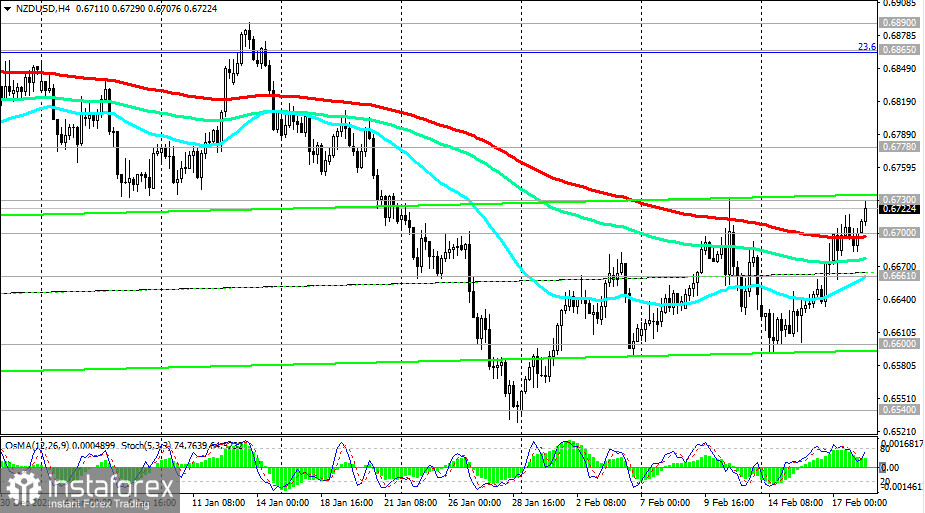Following the meetings held in October and November, the Reserve Bank of New Zealand (for the first time in 7 years) raised the key interest rate to 0.50%, and then to 0.75%. The rate was raised to ease inflation and curb rapidly rising house prices. Earlier, the RBNZ stated that the economy no longer needs the current level of monetary stimulus.
Despite the interest rate hike, the New Zealand dollar weakened, including against the US dollar, after the publication of the Reserve Bank of New Zealand's forecast for the short-term interest rate, which did not meet market expectations. RBNZ executives said at the time that they now intend to take a wait-and-see attitude to assess the impact on the economy from the interest rate decision, and this seems to have disappointed investors.
Usually, an increase in the interest rate has a positive effect on the quotes of the national currency. However, in this case, the market reaction was the opposite. The NZD declined shortly after the publication of the RBNZ's decision to raise the interest rate. The conclusion is that this increase was already embedded in prices, and the restrained position of the RBNZ management regarding the future prospects of monetary policy disappointed investors.
The bank predicted that the rate would peak at 2.6% by the end of 2023 (the previous forecast of the Central Bank assumed that the rate would reach 2.1% by the beginning of 2024). Nevertheless, the forecast turned out to be weaker than expected by the market expectations reflected in the quotes, against the background of various risks and uncertainty of economic prospects.
The New Zealand dollar is also negatively affected by the dynamics of the country's GDP. There was a drop in GDP in the 3rd quarter by -3.7% (after an increase of +2.8% in the 2nd quarter of 2021). Data for the 4th quarter will be published in mid-March 2022, and here, too, economists do not expect strong growth.

The NZD/USD pair has been mostly declining for the previous 3 months and at the end of January, it reached a local 16-month low near the 0.6530 mark. However, this month the NZD/USD is growing, including due to the weakening of the US dollar. The minutes of the Fed's January meeting published earlier this week weakened expectations of a more aggressive tightening of the US central bank's policy.
After last week, the US Department of Labor reported another increase in consumer inflation in the country (the consumer price index (CPI) in January increased by +7.5% (in annual terms) after an increase of 7.0% in December). Talk intensified that Fed officials could raise the interest rate at the March meeting by 50 basis points at once. Some market participants and economists even assumed that the Fed's interest rate would be raised another 5-7 times this year.
However, the minutes of the meeting of the Open Market Committee does not confirm this: they only repeat that decisions to tighten policy will be considered from meeting to meeting.
Nevertheless, the intrigue around the actions of the Fed remains, and before the next meeting on March 15-16, its leaders still have enough time to make further adjustments to their plans for monetary policy.
On Thursday, Fed officials and FOMC members James Bullard and Loretta Mester spoke in favor of tougher measures. Bullard is in favor of raising the key rate by 1 percentage point by July, as well as starting to reduce the Fed's asset portfolio, which is close to $9 trillion, in the 2nd quarter. Although, other members of the Fed leadership do not share his opinion.
Minneapolis Fed President Neel Kashkari said, "If we raise rates too aggressively, we risk a sharp slowdown in the economy, plunge it into a recession, and possibly return it to where it was before the pandemic, when inflation was too weak."
At the time of writing, the NZD/USD pair is trading near the 0.6721 mark, coming close to the strong resistance level of 0.6730. The pair received support yesterday after the publication of weak data from the US on the dynamics of claims for unemployment benefits. The number of initial applications in the previous reporting week increased to 248K (against the forecast of 219Kand the previous value of 225K).
While the views of the Fed leadership regarding the pace of interest rate increases are divided, the RBNZ leadership is pursuing a more transparent policy. Next week the next meeting of the RBNZ will take place, during which, as expected, its interest rate will be raised again to 1.0%. Thus, the RBNZ is becoming a leader in the process of tightening monetary policy among other major world central banks, and this can become a strong and main driver for strengthening the NZD in the next few weeks, although here too much will depend on the current economic situation in the country and in the world.
As a reminder, the decision of the RBNZ on the interest rate will be published on Wednesday at 01:00 (GMT).
Technical analysis and trading recommendations

Despite the growth observed since the beginning of this month, NZD/USD remains in the bear market zone, trading below the key resistance levels of 0.6865 (200 EMA on the weekly chart and the 23.6% Fibonacci retracement level in the global wave of the pair's decline from the level of 0.8820), 0.6890 (200 EMA on the daily chart).

In January, NZD/USD hit a new 16-month low at 0.6540. However, there was no further decline, and the pair corrected, breaking through the important resistance level 0.6700 (200 EMA on the 4-hour chart and December lows) and coming close to the resistance level 0.6730 (50 EMA on the daily chart).

The zone of levels 0.6700 and 0.6730 is a fairly strong resistance zone, for the breakdown of which and further growth, the NZD/USD pair will need solid grounds and fairly strong drivers. Until Wednesday, when the RBNZ meeting takes place, they are unlikely to appear, unless, of course, sellers of the US dollar want to lower its quotes in the thin market on Monday, when US banks and exchanges will be closed on the occasion of Presidents Day.
In this case, and after the meeting of the RBNZ on Wednesday, the NZD/USD has the prospect of growth towards the key resistance levels of 0.6865, 0.6890.
In an alternative scenario, and after the breakdown of the support level of 0.6700, NZD/USD will head towards the local support levels of 0.6600, 0.6540 with the prospect of a deeper decline within the descending channel on the weekly chart.
In the current situation, the determining factor in the dynamics of NZD/USD is likely to be the course of the monetary policy of the central banks of the United States and New Zealand. And, most likely, the conditional "scale" will tilt towards the currency of the country whose central bank takes a tougher stance. In general, the downward dynamics of NZD/USD is still prevailing.
Support levels: 0.6700, 0.6661, 0.6600, 0.6540, 0.6500
Resistance levels: 0.6730, 0.6780, 0.6865, 0.6890, 0.6950, 0.7100, 0.7170, 0.7240, 0.7315, 0.7380, 0.7430, 0.7550, 0.7600
Trading recommendations
Sell Stop 0.6680. Stop-Loss 0.6735. Take-Profit 0.6660, 0.6600, 0.6540, 0.6500, 0.6260
Buy Stop 0.6735. Stop-Loss 0.6680. Take-Profit 0.6780, 0.6865, 0.6890, 0.6950, 0.7100, 0.7170, 0.7240, 0.7315, 0.7380, 0.7430, 0.7550, 0.7600
 English
English 
 Русский
Русский Bahasa Indonesia
Bahasa Indonesia Bahasa Malay
Bahasa Malay ไทย
ไทย Español
Español Deutsch
Deutsch Български
Български Français
Français Tiếng Việt
Tiếng Việt 中文
中文 বাংলা
বাংলা हिन्दी
हिन्दी Čeština
Čeština Українська
Українська Română
Română

